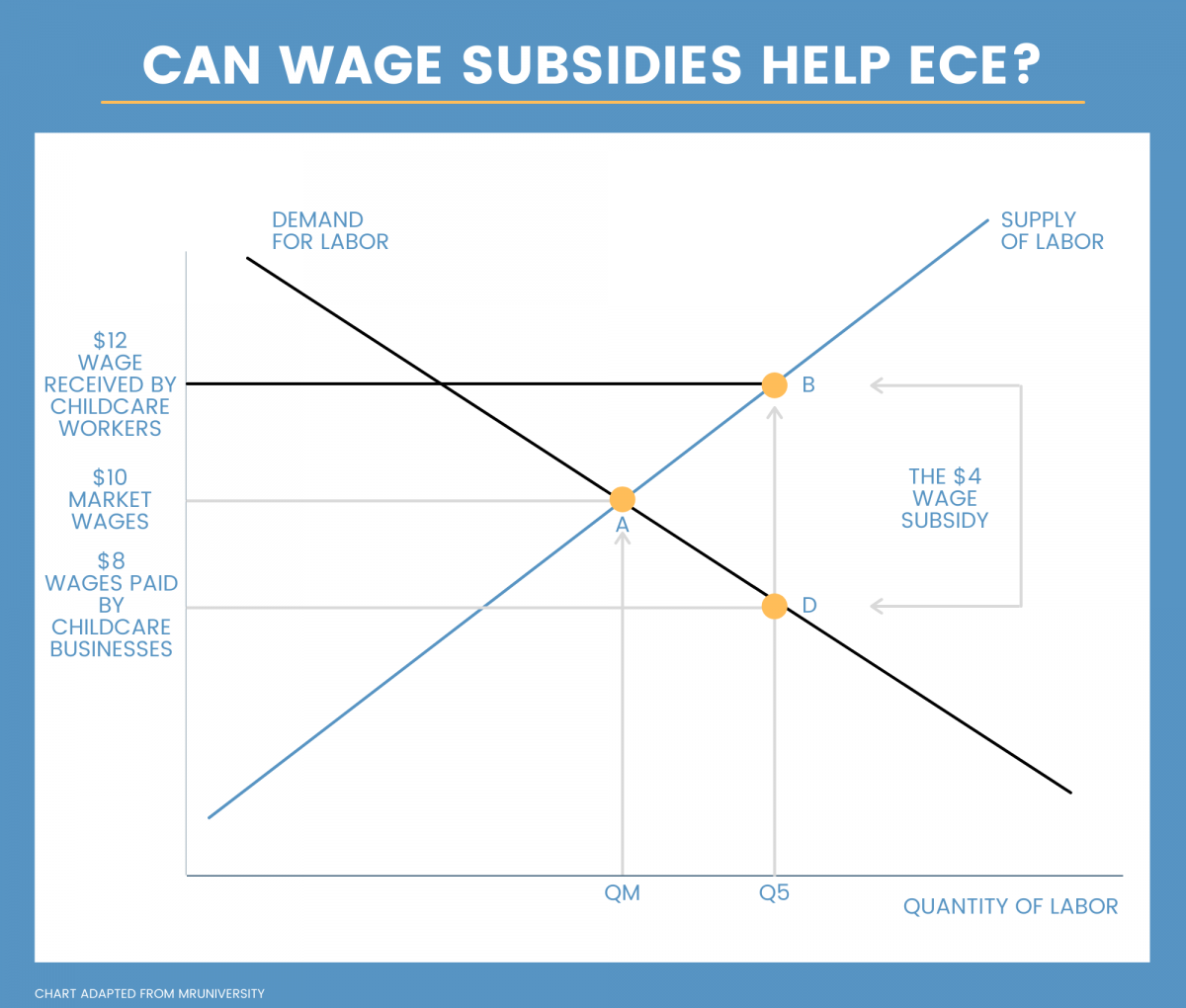Can Wage Subsidies Be the Answer to Higher Pay in Childcare?

Published Date: 01/30/20
According to payscale.com, the average pay for a childcare worker is $9.94 per hour, just $1.35 more than the average fast food worker. For a preschool teacher, that number is $12.71. A director, just $16.61 hourly. For reference, according to MIT, a living wage in the United States in 2017 was $16.07 per hour. In a household of two adults and two children, the adults must work 76 hours per week at the federal minimum wage of $7.25 per hour to eke out a living.
But you already know this. If not the specifics, you know that the industry is grossly underpaid and most feel as if their hands are tied. Profits are already low and tuition is already high. There’s little left to give.
Yet, without higher pay, we can improve neither the amount of staff nor the qualifications of those workers. NAEYC’s Power to the Profession (P2P) is calling for greater investment from the public sector to help raise pay, with their latest draft saying the following:
“Use increased public funding to ensure the following accountability expectations for employers are met:
- Employers provide salaries comparable to the public K-12 education sector for similarly qualified employees,
- Employers provide competitive benefits packages for employees that include paid leave, medical insurance, and retirement savings,
- Hiring qualified staff to perform responsibilities that are within their designated scope, with a priority of hiring a diverse workforce that reflects the population served, and
- Implementing work schedules, materials and staffing models, culture, leadership, and other components of a system that leads to effective development and education of young children and well-being of employees.”
While there are some components of P2P we disagree on, this we support fully. We believe that funding must come from the public sector to raise wages for childcare workers across the United States. But how? Our feeling is that direct wage subsidies might be the right solution.
But how does they work and what are the implications?
Many daycare and preschool owners cannot afford to run a profitable business while facing continued minimum wage increases. More so, we believe childcare workers provide a critical service and deserve to be paid more than the bare minimum. Wage subsidies can adequately address these needs. They are, in short, a direct payment to certain workers to raise their pay. They can be used to offset the salary paid by daycare and preschool owners, leaving you with additional funds to hire more staff, reinvest in your business, lower childcare costs to parents, or simply, increase your profits.
Examining the chart below, we look at how direct wage subsidies affect the childcare labor force. For illustration purposes, we’re using $10 as the standard wage in childcare. Currently, daycare and preschool owners pay 100% of that $10. The more money a childcare worker wants to be paid, the less in-demand she or he is. A wage subsidy comes in from the government where daycare and preschool owners are now only paying $8 per hour, but workers are receiving $12 per hour.

Three things then happen:
1) Labor supply increases - higher wages attract more talent
2) Because of that higher pay the industry can raise training requirements for staff
3) Increased profits in daycares and preschools that can be reinvested in the business
At this point you’re probably saying, “Super! But where does that money come from?”
Well, some of it comes from new taxes (some politicians are proposing an ultra-millionaire tax to pay for childcare-related expenses). However, some of it comes from a reallocation of existing funds. Depending on the state, up to 50% of childcare workers are receiving some form of government assistance. Higher wages mean fewer childcare workers living in poverty, which means money that was previously spent providing programs like SNAP can now be spent on wages instead. A University of California Berkeley study found that the combined state and federal government spend on benefits to low-wage workers exceeds $150 billion annually.
Are there drawbacks? Potentially.
Especially with childcare, anytime you consider accepting government money you open the door to additional regulation. One potential regulation could be that only providers who accept subsidies from families are eligible for wage subsidies. Another may be increased regulation of worker qualifications. While doubtful, the government could decide to lower ratios, essentially forcing you to reinvest the additional money into hiring more staff. The primary concern should be that regulations are often largely regressive, affecting the most low-income providers and at-risk children disproportionately. For example, if the government decided to require college degrees in order for childcare workers to receive the wage subsidy, this would undoubtedly mean fewer providers in low-income areas receiving it. That would have a negative impact on the industry, creating more of a chasm in the quality of care between affluent areas and impoverished ones.
Both conservative and liberal outlets have written on the benefits of wage subsidies. Conservative think tank The Manhattan Institute published the brief, The Wage Subsidy: A Better Way to Help the Poor while the left-leaning New York Times and U.S. News and World Report have published, A Smarter Way to Raise Paychecks and A Better Wage Hike respectively, with all coming to the conclusion that wage subsidies are beneficial to fighting poverty.
It’s important to note that the wage subsidies we’re discussing are not the same thing as the Earned Income Tax Credit (EITC). A wage subsidy is paid on each paycheck for every hour worked, whereas the EITC is payed after the fact on total income earned.
While thought leaders in early childhood education, we’re not economists. However, in 1997 Nobel laureate Edmund Phelps published the book Rewarding Work: How to Restore Participation and Self-Support to Free Enterprise. His proposed wage subsidy program had an annual cost of $185 billion. He further proposed that funds be rerouted from existing programs, and accounting for the effects of speculated increased employment, the net cost was zero.
When we talk about raising wages in childcare, most are in agreement that it’s a necessity to attract talent to the profession, mitigate turnover, and raise the standard of care nationwide. We need to start looking at exactly how that will be done and initiate studies to make it happen quickly.
Have thoughts about wage subsidies or other ways to increase compensation in childcare? We'd love to hear your soutions. Email us at [email protected]
Paper Pinecone is the #1 most trusted childcare directory. Childcare providers list free so parents can find the best daycare and preschools in their area.
- stacey's blog
- Log in or register to post comments







